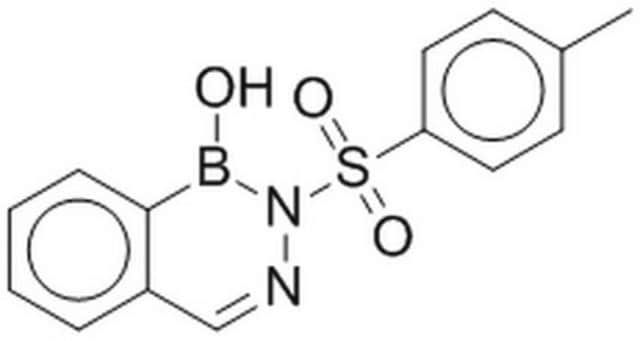Wichtige Dokumente
P0025
Platensimycin
≥90% (HPLC), from Streptomyces platensis
About This Item
Empfohlene Produkte
Biologische Quelle
Streptomyces platensis
Assay
≥90% (HPLC)
Form
solid
Farbe
white to beige
Löslichkeit
DMSO: 1 mg/mL, clear, colorless
Wirkungsspektrum von Antibiotika
Gram-negative bacteria
Gram-positive bacteria
Wirkungsweise
enzyme | inhibits
Lagertemp.
−20°C
SMILES String
O=C1C=C[C@]2(C[H])[C@H]3CC[C@@](O3)([H])C2C1CCC(CNC4=C(O)C=CC(C(O)=O)=C4O)=O
InChI
1S/C22H25NO7/c1-22-9-8-14(25)12(18(22)16-6-7-17(22)30-16)3-2-11(24)10-23-19-15(26)5-4-13(20(19)27)21(28)29/h4-5,8-9,12,16-18,23,26-27H,2-3,6-7,10H2,1H3,(H,28,29)/t12?,16-,17+,18?,22+/m0/s1
InChIKey
IGBNLKVUOHQLTO-MBQNLBDGSA-N
Anwendung
Biochem./physiol. Wirkung
Mode of action: Selectively inhibits lipid biosynthesis by targeting FabF/B within the fatty acid synthesis pathway.
Antimicrobial spectrum: Gram-positive bacteria.
Sonstige Hinweise
Lagerklassenschlüssel
11 - Combustible Solids
WGK
WGK 3
Flammpunkt (°F)
Not applicable
Flammpunkt (°C)
Not applicable
Hier finden Sie alle aktuellen Versionen:
Analysenzertifikate (COA)
Die passende Version wird nicht angezeigt?
Wenn Sie eine bestimmte Version benötigen, können Sie anhand der Lot- oder Chargennummer nach einem spezifischen Zertifikat suchen.
Besitzen Sie dieses Produkt bereits?
In der Dokumentenbibliothek finden Sie die Dokumentation zu den Produkten, die Sie kürzlich erworben haben.
Active Filters
Unser Team von Wissenschaftlern verfügt über Erfahrung in allen Forschungsbereichen einschließlich Life Science, Materialwissenschaften, chemischer Synthese, Chromatographie, Analytik und vielen mehr..
Setzen Sie sich mit dem technischen Dienst in Verbindung.




![Adenosin-5′-[γ-thio]triphosphat Tetralithiumsalz ≥75% (HPLC), powder](/deepweb/assets/sigmaaldrich/product/structures/319/398/e29221c2-3649-455b-bd33-583bb017ec7d/640/e29221c2-3649-455b-bd33-583bb017ec7d.png)



